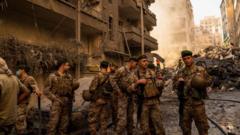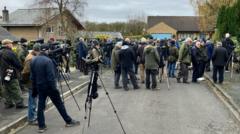Potential Ceasefire Negotiations Between Israel and Hezbollah
The Israeli cabinet is set to meet and discuss a proposed 60-day ceasefire with the Lebanese militia Hezbollah, with potential diplomatic breakthrough appearing imminent. The proposed agreement includes several key provisions that could temporarily halt hostilities along the Israel-Lebanon border.
Under the proposed deal, Israeli forces would withdraw from Lebanon, and Hezbollah would retreat from areas south of the Litani River, with Lebanese Army troops taking their place. The potential agreement, which is being mediated by the United States and France, includes several critical components:
1. A mutual ceasefire
2. Israeli Defense Forces (IDF) presence in Lebanon for up to 60 days
3. Lebanese Army replacing IDF during withdrawal
4. No Israeli-occupied buffer zone in southern Lebanon
5. A five-country committee, led by the US, to monitor ceasefire implementation
6. Lebanese government oversight of arms purchases and production
Israeli Prime Minister Benjamin Netanyahu has reportedly agreed to the deal “in principle,” with the US and France expecting to announce the ceasefire soon. The French presidency noted that negotiations have “significantly advanced” and urged both parties to seize the opportunity.
However, the potential agreement is not without opposition. Itamar Ben-Gvir, Israel’s far-right national security minister, has spoken out against the ceasefire, arguing that Israel should continue fighting until achieving “absolute victory.”
The proposed terms are largely based on United Nations Security Council Resolution 1701, which ended the 2006 war between Hezbollah and Israel. The resolution calls for the withdrawal of Hezbollah fighters and weapons from areas between the Blue Line and the Litani River.
The conflict, which began on October 8, 2023, when Hezbollah fired rockets at Israel in support of Hamas’s attack, has resulted in significant casualties and displacement. In Lebanon, over 3,750 people have been killed, 15,600 injured, and more than one million forced from their homes.
Israel’s primary stated goal is to enable the return of approximately 60,000 residents displaced from northern Israeli communities due to Hezbollah attacks. In September, Israel launched a major escalation, destroying much of Hezbollah’s infrastructure and weapons and killing its leader Hassan Nasrallah and other senior figures.
While these negotiations show promise, parallel talks to end the war in Gaza remain deadlocked, with Qatar recently withdrawing as a mediator between Israel and Hamas.
As diplomats suggest a deal is close, fierce fighting continues, with Lebanese authorities reporting at least 31 killed in Israeli air strikes and Hezbollah firing rocket barrages at Israel. The Israeli cabinet’s meeting on Tuesday is expected to be crucial in determining the potential ceasefire’s fate.




